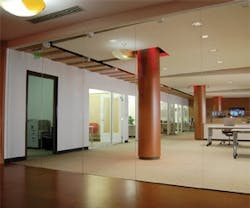Soundmasking in a Green Office
Thermal comfort, daylighting, and healthy indoor air – green office buildings have a lot to offer. One area where they consistently fall short, though, is speech privacy. "Since acoustical requirements are not yet a part of the LEED-CI rating system, acoustical performance is often not on designers’ radar screens," report Ethan Salter, Karen Costello, Kenneth Graven, and Ross Jerozal, acoustical and audiovisual/telecommunications consultants with San Francisco-based Charles M. Salter Associates Inc.
Both the design of an office space and its materials should be carefully considered to address the ABCs (absorb, block, and cover) of acoustics; this has proven effective for ensuring speech privacy for years. According to Charles C. Roy, president, CCR Associates LLC, an Essex, CT-based acoustical consulting firm, "… the absorption (ceilings, furniture, and carpet), blocking (walls, furniture, and ceilings) and covering of sound (controlling the ambient background with soundmasking) are critical components in addressing office acoustics. In general, when one segment or another is ignored, the cumulative outcome for speech privacy will be less than when all are addressed equally." Unfortunately, new ideas about green design and emerging technologies have made applying this strategy more challenging.
Daylighting vs. Soundmasking
"Poor acoustics certainly can be prevalent in a non-LEED building, but it’s for certain that it’s going to be there in a LEED building," says Tom Margenau, president and CEO, Margenau Associates Inc., a Denver-based acoustical design/build firm. One example: Some LEED points are achieved by installing shorter systems furniture panels, which increase the infiltration of daylighting from perimeter windows. "The furniture panels act as an acoustical barrier if they’re higher than 53 inches. When you use shorter panels, you’re missing the barrier portion of speech privacy," Margenau explains.
Newer HVAC technology, according to Margenau, can also impact acoustics in an open-plan office environment. Underfloor air distribution systems are quieter, resulting in lower levels of ambient noise and, consequently, less speech privacy.
To help compensate for less ambient noise, a soundmasking system should be installed. Soundmasking is the introduction of a low-level artificial noise into a space to cover (or mask) conversations, decreasing intelligibility. "There isn’t an office building today that doesn’t need soundmasking," says Margenau. "Soundmasking is the most cost-effective and acoustically effective thing you can do for speech privacy."
Types of Systems
There are three different kinds of soundmasking systems: centralized, distributed (also called decentralized), and networked. When investigating which manufacturer’s system is right for your office, consider more than price and system performance: think green. Ask about the percentage of recycled content, the amount of wire/cable required, post-use recyclability of components, and how much energy will be consumed. "Low-voltage soundmasking systems use lower power amplifiers distributed throughout the ceiling plenum. In a low-voltage system, a single amplifier may serve just one or two loudspeakers. High-voltage systems typically use a single, centralized power amplifier, usually stored in a closet or equipment room," explain the professionals at Salter Associates.
When the Salter team embarked on a renovation of its 4,500-square-foot San Francisco office, green products were selected for their acoustical performance, and soundmasking was installed. The team even received Innovation in Design (ID) credits from the U.S. Green Building Council for acoustical performance. The key to successfully achieving a green office with adequate speech privacy, says the team, was considering acoustics at the project’s onset. This kept project costs from escalating unnecessarily as well.
According to the Salter team, "If acoustical performance is addressed from the initial LEED design charrette through design into occupancy, our experience is that achieving acceptable acoustics in a green project often does not increase costs substantially."
